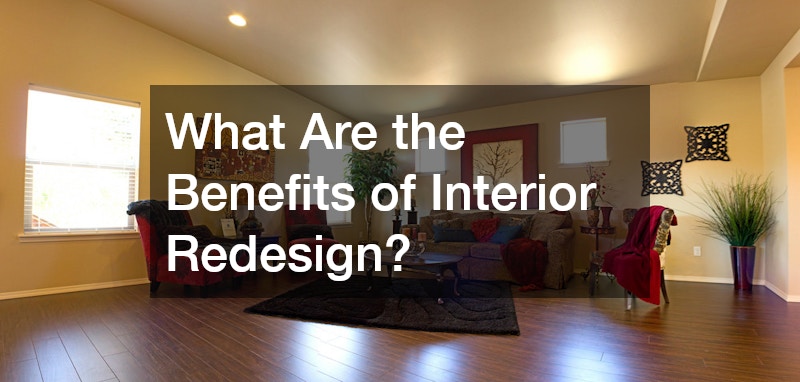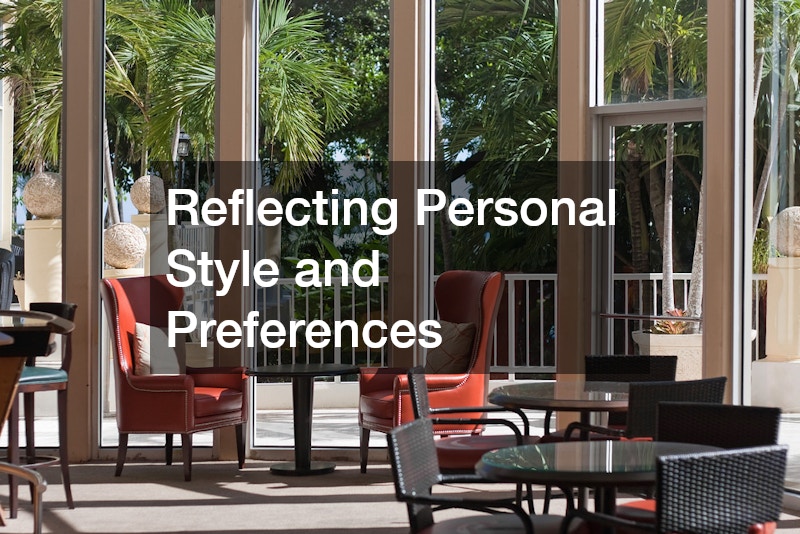
What Are the Benefits of Interior Redesign?

Planning Out Your New Home Project
Interior redesign offers homeowners a transformative way to refresh their spaces, blending beauty, function, and modern comforts in every room. Beyond simply changing the look of a home, redesigning the interior can have meaningful impacts on daily life, as thoughtfully crafted spaces can enhance mood, encourage productivity, and support relaxation. A well-planned interior redesign is not just about aesthetics; it incorporates elements that serve practical needs, adjust for energy efficiency, and provide long-term benefits. By rethinking a room’s layout, adding functional decor, or simply updating colors and finishes, interior redesign can elevate the experience of living in a home in substantial ways.

Enhancing Aesthetic Appeal in Your Home
The interior redesign brings with it the ability to reimagine a home’s aesthetic appeal, creating an environment that feels fresh and visually captivating. A new color palette, modern textures, and updated finishes can bring life to tired spaces and create a harmonious flow throughout the home. Paint, for instance, is a powerful way to update a home’s aesthetic without major renovations. The right colors can add warmth, sophistication, or vibrancy, setting the mood for each room. With a cohesive design scheme, interior redesign elevates a home’s aesthetic, making it feel more inviting and stylish.
For a more specific transformation, working with a painting contractor can bring professional expertise to the project, ensuring the paint application is precise, durable, and true to the vision. A professional painter can help with color selection, wall preparation, and application techniques that make a real difference in the overall quality. Whether it’s creating a feature wall, using textured paints, or experimenting with bold colors, a painting contractor can provide the insight and skills needed to enhance the aesthetic appeal of a home through strategic interior redesign.
Improving Functionality and Space Utilization
Interior redesign isn’t solely about appearances; it’s also about optimizing how each space functions to better serve the people who live there. By reorganizing furniture, adjusting layouts, or upgrading features, a redesign can make spaces more practical and enjoyable to use. Improved functionality can be achieved through simple adjustments like rearranging furniture or through more involved changes, such as adding custom cabinetry or smart storage solutions. Every corner of a home can be utilized to its fullest potential, turning underused areas into functional assets and making day-to-day life smoother and more efficient.
A specific approach to enhancing functionality involves consulting with a flooring company to upgrade or replace flooring materials. High-quality flooring can improve space utilization by creating clear, defined areas for different activities, making a room feel both structured and expansive. For example, durable and easy-to-clean flooring in high-traffic areas can improve practicality, while soft, noise-dampening materials in quieter spaces can create cozy, inviting spots for relaxation. With the right flooring choices, a flooring company can help bring both function and beauty to an interior redesign.

Boosting Property Value Through Design
Interior redesign is a valuable investment that can significantly boost a home’s property value. By making strategic updates, homeowners can modernize their space, making it more appealing to potential buyers. Whether it’s through contemporary design elements, high-quality materials, or energy-efficient upgrades, interior redesign can add to a home’s overall worth. Thoughtful redesign choices enhance both functionality and aesthetic appeal, which are attractive features for prospective buyers. Increasing property value through design can turn a simple redesign into a smart financial move, making the home more desirable in a competitive market.
Focusing specifically on key areas like bath remodeling can yield high returns on investment. Bathrooms are essential spaces where functionality and style need to coexist seamlessly, and an updated bathroom can leave a lasting impression on potential buyers. A bath remodel that incorporates modern fixtures, efficient lighting, and a fresh layout not only makes the space more enjoyable for current residents but also adds value in a way that stands out during a home appraisal or sale. When interior redesign prioritizes areas like the bathroom, it becomes a strategic tool for increasing property value.
Increasing Comfort and Livability
Interior redesign has the power to transform a home into a comfortable, inviting space that enhances daily life. By tailoring design elements to meet personal needs and preferences, homeowners can create a more enjoyable living environment. Redesigned spaces can focus on comfort by incorporating features like ergonomic furniture, soft textures, and efficient layouts that make rooms feel open and welcoming. Whether it’s a cozy reading nook or a relaxing family room, interior redesign can make each room feel uniquely suited for comfort and ease, promoting a higher quality of life.
In particular, kitchen remodeling can play a major role in boosting livability. Kitchens are central to daily routines, and a remodel that enhances both functionality and aesthetics can make meal preparation, dining, and entertaining more enjoyable. Adding elements like additional storage, upgraded appliances, and well-designed lighting can make a kitchen more user-friendly and comfortable. An interior redesign that centers on kitchen improvements can create a heart of the home where family and friends love to gather, boosting the overall livability of the space.

Reflecting Personal Style and Preferences
Interior redesign offers homeowners the opportunity to bring their style into every corner of their home. Through choices in color schemes, materials, furniture, and decor, redesign allows for a unique and tailored expression of personality. Whether one prefers minimalist aesthetics, vintage charm, or bold, modern accents, redesigning a home’s interior helps bring these tastes to life. Interior redesign is about creating a living environment that feels authentic to the homeowner, with every detail contributing to a space that reflects their identity and preferences.
When it comes to a basement remodeler, this personal touch can transform an often-underused space into something truly special. A basement can become an entertainment room, home office, or even a personal gym—whatever best suits the homeowner’s lifestyle and vision. A basement remodel that aligns with individual preferences can turn an unfinished or cluttered area into a comfortable, functional part of the home that feels uniquely theirs. Interior redesign focused on personal style and preferences makes a home feel more like a sanctuary, with each room serving a purpose that resonates with its residents.
Maximizing Natural Light and Ventilation
Interior redesign can make a home brighter and more inviting by maximizing natural light and improving ventilation. A well-lit space has a positive impact on mood and can make rooms feel larger and more open. Redesign strategies such as adding larger windows, skylights, or reflective surfaces help increase natural light, creating a warm and airy atmosphere. Improved ventilation, on the other hand, can lead to better air quality, making the home healthier and more comfortable. An interior redesign that focuses on light and airflow brings life into spaces, making them feel fresher and more dynamic.
A roofing company can play a key role in this transformation by adding or optimizing skylights, which are effective in bringing natural light into areas that may otherwise feel dim or enclosed. In addition, proper roofing ventilation helps regulate indoor temperature and airflow, keeping spaces comfortable throughout the year. By integrating natural light and ventilation enhancements, interior redesign can create a healthier, brighter environment that enhances the overall quality of the home.

Promoting Energy Efficiency and Sustainability
Interior redesign can support sustainability by focusing on energy efficiency, reducing a home’s environmental footprint while lowering utility costs. Sustainable design incorporates materials, appliances, and systems that consume less energy and water. Choices like energy-efficient lighting, low-flow fixtures, and eco-friendly materials help create a space that’s both stylish and environmentally conscious. By prioritizing sustainable options, interior redesign aligns the home with modern values, promoting a lifestyle that respects natural resources while enhancing comfort and efficiency.
A specific example is updating plumbing to support water conservation, where plumbing repairs can ensure efficient water use. Modernizing plumbing systems can minimize leaks, reduce water waste, and support eco-friendly practices like recycling greywater. With strategic plumbing upgrades, interior redesign can turn sustainability goals into practical, everyday actions. This approach not only benefits the environment but also contributes to a home that operates more smoothly and efficiently, reinforcing the value of sustainable interior redesign.
Creating a Healthier Living Environment
A key benefit of interior redesign is the ability to create a healthier living environment, one that promotes well-being for all residents. By carefully selecting non-toxic materials, improving ventilation, and ensuring proper lighting, redesign efforts can make a home safer and more comfortable. Elements like indoor plants, natural materials, and effective air filtration can improve indoor air quality, reducing exposure to allergens and pollutants. An interior redesign that prioritizes health supports a clean, calming environment, contributing to overall physical and mental wellness.
Engaging an electrical contractor can enhance this goal by ensuring that electrical systems are safe and up to code. Proper wiring, updated outlets, and safe lighting installations are essential for creating a hazard-free environment. Additionally, upgrading to energy-efficient lighting can reduce eye strain and improve the ambiance of a room. An interior redesign that incorporates safe and efficient electrical systems contributes to a healthier, more comfortable living space, aligning with the overall goal of enhancing well-being through design.
Adapting to Changing Lifestyle Needs
Interior redesign allows homes to evolve in response to changing lifestyle needs, making spaces more adaptable and functional over time. As families grow or lifestyles shift, a home that once felt spacious and organized may require adjustments to maintain comfort and convenience. Interior redesign can help by repurposing rooms, adding flexible layouts, and introducing multifunctional furniture that caters to new needs. This adaptability ensures that a home remains a comfortable and efficient space that evolves along with its residents.
One way to support changing needs is through incorporating sustainable materials, such as working with metal recycling to bring eco-friendly choices into the home. Recycled metal can be used in various design elements, from accent pieces to structural features, offering both durability and a modern aesthetic. By incorporating adaptable, eco-friendly materials, interior redesign can create spaces that are both versatile and aligned with sustainable practices, ensuring that the home supports the needs of its occupants now and in the future.
Supporting Mental Well-Being Through Design
A thoughtfully designed interior can significantly contribute to mental well-being by creating a calming, supportive atmosphere. Elements such as soothing color palettes, natural lighting, and clutter-free layouts can promote relaxation and reduce stress, turning the home into a retreat from the outside world. Interior redesign that prioritizes mental well-being aims to create a balanced environment where individuals feel more at ease, focused, and connected to their space. Integrating wellness-centered design principles can lead to a healthier state of mind and a more harmonious living experience.
For a practical example, incorporating the expertise of a chimney service can ensure proper ventilation, which not only supports physical health but also contributes to a sense of comfort and peace of mind. A well-maintained chimney improves air quality, provides warmth, and enhances the overall ambiance, making a living space feel cozy and secure. By focusing on elements that support mental well-being, interior redesign creates a home environment that nurtures both body and mind.
Maintaining New Interior Changes
Interior redesign is a powerful tool for transforming a home into a space that aligns with the needs, preferences, and values of its residents. Beyond enhancing visual appeal, redesign can improve functionality, increase property value, and adapt spaces to support changing lifestyles. It also offers the chance to create a healthier and more sustainable environment, allowing homeowners to make choices that benefit both their immediate comfort and the planet. Thoughtful interior redesign can profoundly impact the overall living experience, making each room a meaningful and enjoyable part of daily life.
Whether through maximizing natural light, promoting energy efficiency, or tailoring spaces to reflect personal style, interior redesign provides endless possibilities for improving a home. With careful planning and attention to detail, every redesign project can enhance not only the home’s aesthetic but also the quality of life for its occupants. By embracing the transformative potential of interior redesign, homeowners can create a space that is beautiful, functional, and supportive of their well-being in every way.